
“
Carpal Tunnel Syndrome Explained focuses on a nerve-related condition that affects millions globally, often caused by repetitive wrist motions or underlying health issues. It compresses the median nerve running through the wrist’s carpal tunnel, resulting in tingling, numbness, and weakness in the hand. This condition is commonly seen among computer users, factory workers, and anyone performing repetitive wrist tasks. 1
1
”
Dr. Pierre Marie, a pioneering French neurologist, helped shape early research on nerve compressions, paving the way for understanding carpal tunnel syndrome and how pressure on nerves leads to lasting damage. 1
This syndrome is among the most diagnosed nerve entrapments, particularly affecting people in repetitive-hand-movement jobs like typing, sewing, carpentry, or factory work involving constant hand strain. 2

Cold weather often worsens symptoms by slowing blood flow and increasing stiffness, making hands more sensitive to pain and numbness caused by carpal tunnel pressure on the nerve.
Common early symptoms include tingling, numbness, or burning in the thumb, index, and middle fingers—often worsening at night or during activities requiring prolonged hand or wrist positioning. 3
Chronic illnesses like diabetes, hypothyroidism, and rheumatoid arthritis are linked to carpal tunnel syndrome, as these conditions can cause tissue swelling or reduce nerve health and function. 4
Wrist injuries, including fractures and sprains, can change the carpal tunnel’s shape, reducing space for the median nerve and causing persistent hand issues unless addressed properly with therapy. 5
The Phalen’s test involves flexing both wrists for about one minute. If this causes tingling or numbness, it suggests pressure on the median nerve inside the carpal tunnel. 6
Wrist splints, especially at night, help hold the hand in a neutral position. This relieves pressure on the median nerve and can prevent symptoms from worsening during sleep. 7
Over-the-counter anti-inflammatory medicines like ibuprofen can reduce swelling and discomfort from mild carpal tunnel symptoms, offering temporary relief when paired with rest and reduced hand activity. 8

Corticosteroid injections into the carpal tunnel may temporarily ease symptoms by reducing swelling, particularly in people who aren’t ready for or wish to avoid immediate surgery.
Surgery for carpal tunnel syndrome cuts the ligament pressing on the nerve, creating more room in the tunnel. It’s usually done under local anesthesia and has a high success rate. 9
If untreated, carpal tunnel syndrome may cause permanent nerve damage and muscle wasting at the base of the thumb, significantly reducing grip strength and fine hand coordination. 10
Simple ergonomic changes—like wrist rests, hand-friendly tools, or adjusted keyboard heights—can significantly lower the risk of developing carpal tunnel syndrome, especially for desk workers and typists. 11
The carpal tunnel is barely one inch wide. Even slight tissue swelling from overuse or inflammation can dramatically increase pressure and irritate the sensitive median nerve inside. 12
People with symptoms in both hands may struggle with writing, opening jars, buttoning shirts, or other everyday tasks, leading to frustration and increased dependency on others if untreated. 13

Typing, vibrating tool use, or repetitive wrist flexing can lead to inflammation inside the carpal tunnel, compressing the median nerve and triggering uncomfortable symptoms that worsen over time.
Recovery time after surgery varies. Some patients return to daily tasks within weeks, while others require months of therapy to regain strength, coordination, and full function of their hand. 14
Professions like musicians, chefs, hairdressers, and mechanics face a high risk due to repeated hand motions, increasing the chance of nerve compression and carpal tunnel-related hand dysfunction. 15
When ignored, carpal tunnel syndrome can cause permanent thumb muscle atrophy, making simple tasks like gripping a cup or holding a pen very difficult, even after later treatment. 16
Sleeping with bent wrists can trigger or worsen symptoms overnight. Night splints help maintain a straight position and reduce the risk of nerve pressure during hours of rest. 17


